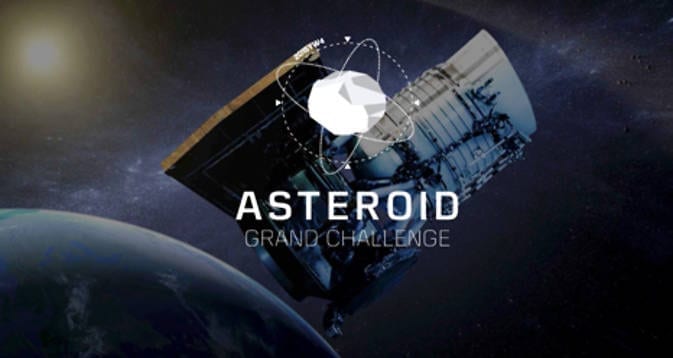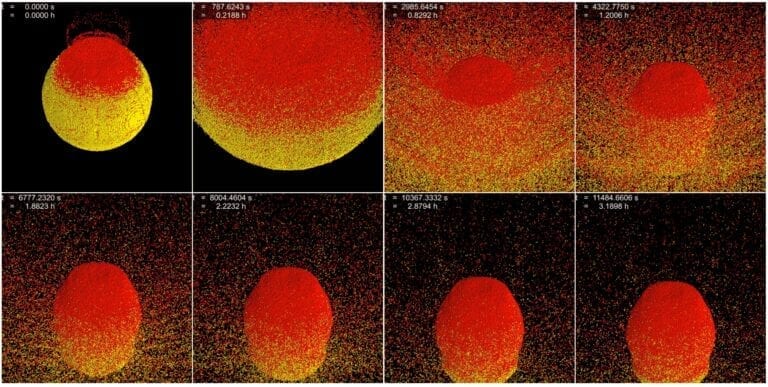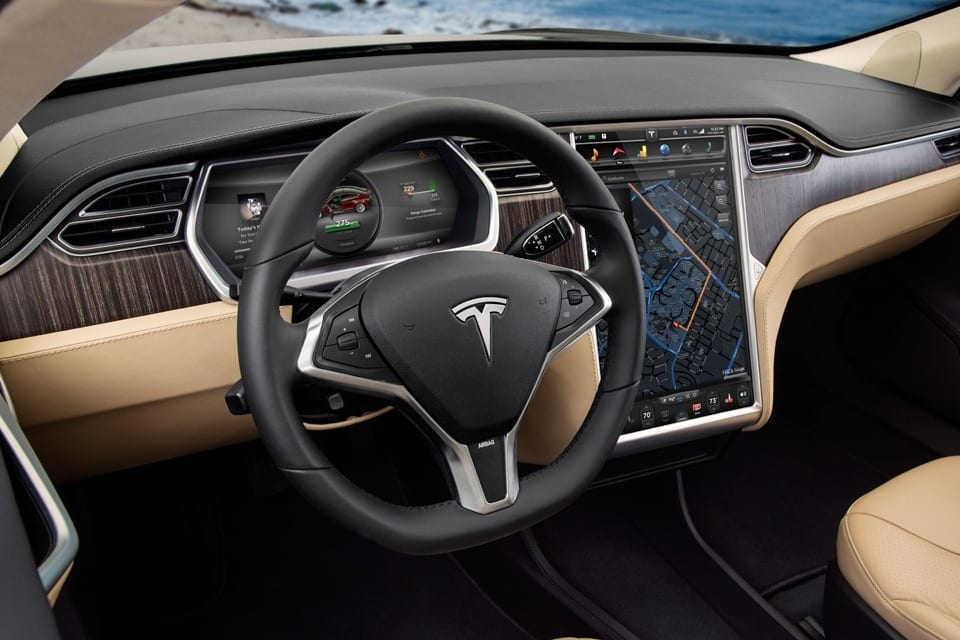
Image Credit: NASA
A software application based on an algorithm created by a NASA challenge has the potential to increase the number of new asteroid discoveries by amateur astronomers.
Analysis of images taken of our solar system’s main belt asteroids between Mars and Jupiter using the algorithm showed a 15 percent increase in positive identification of new asteroids.
During a panel Sunday at the South by Southwest Festival in Austin, Texas, NASA representatives discussed how citizen scientists have made a difference in asteroid hunting. They also announced the release of a desktop software application developed by NASA in partnership with Planetary Resources, Inc., of Redmond, Washington. The application is based on an Asteroid Data Hunter-derived algorithm that analyzes images for potential asteroids. It’s a tool that can be used by amateur astronomers and citizen scientists.
The Asteroid Data Hunter challenge was part of NASA’s Asteroid Grand Challenge. The data hunter contest series, which was conducted in partnership with Planetary Resources under a Space Act Agreement, was announced at the 2014 South by Southwest Festival and concluded in December. The series offered a total of $55,000 in awards for participants to develop significantly improved algorithms to identify asteroids in images captured by ground-based telescopes. The winning solutions of each piece of the contest combined to create an application using the best algorithm that increased the detection sensitivity, minimized the number of false positives, ignored imperfections in the data, and ran effectively on all computer systems.
“The Asteroid Grand Challenge is seeking non-traditional partnerships to bring the citizen science and space enthusiast community into NASA’s work,” said Jason Kessler, program executive for NASA’s Asteroid Grand Challenge. “The Asteroid Data Hunter challenge has been successful beyond our hopes, creating something that makes a tangible difference to asteroid hunting astronomers and highlights the possibility for more people to play a role in protecting our planet.”
The data hunter challenge incorporated data provided by the Minor Planet Center (MPC), at the Harvard-Smithsonian Center for Astrophysics in Cambridge, Massachusetts, and images provided by the Catalina Sky Survey, an astronomical survey project run by the University of Arizona, Tucson, and focused on the discovery and study of near-Earth asteroids and comets.
“We applaud all the participants in the Asteroid Data Hunter challenge. We are extremely encouraged by the algorithm created and it’s already making a difference. This increase in knowledge will help assess more quickly which asteroids are potential threats, human destinations or resource rich,” said Chris Lewicki, president and chief engineer at Planetary Resources. “It has been exciting for our team to work with NASA on this project, and we also look forward to future space-based systems leveraging these results.”
Astronomers find asteroids by taking images of the same place in the sky and looking for star-like objects that move between frames, an approach that has been used since before Pluto was discovered in 1930. With more telescopes scanning the sky, the ever-increasing volume of data makes it impossible for astronomers to verify each detection by hand. This new algorithm gives astronomers the ability to use computers to autonomously and rapidly check the images and determine which objects are suitable for follow up, which leads to finding more asteroids than previously possible.
“The beauty of such archives is that the data doesn’t grow stale, and with novel approaches, techniques and algorithms, they can be harvested for new information. The participants of the Asteroid Data Hunter challenge did just that, probing observations of the night sky for new asteroids that might have slipped through the software cracks the first time the images were analyzed,” said Jose Luis Galache of the MPC. “Moreover, this software can now be used to analyze new images and is available to any observer who wants to use it. The Minor Planet Center applauds these efforts to provide superior tools to all, and looks forward to receiving new asteroid observations generated with them.”
The desktop software application is free and can be used on any basic desktop or laptop computer. Amateur astronomers may take images from their telescopes and analyze them with the application. The application will tell the user whether a matching asteroid record exists and offer a way to report new findings to the Minor Planet Center, which then confirms and archives new discoveries.
Read more: New Desktop Application Has Potential to Increase Asteroid Detection, Now Available to Public
The Latest on: Asteroid Data Hunter challenge
[google_news title=”” keyword=”Asteroid Data Hunter challenge” num_posts=”10″ blurb_length=”0″ show_thumb=”left”]
via Google News
The Latest on: Asteroid Data Hunter challenge
- Video: Using a hopping robot for asteroid explorationon May 7, 2024 at 10:16 am
One day the SpaceHopper will be deployed on space missions to explore relatively small celestial bodies such as asteroids and moons. These are thought to contain valuable mineral resources that could ...
- Technology Newson May 5, 2024 at 5:00 pm
sailors and air force members have been exposed in a data breach at a payroll system YouTube expanded an AI feature that allows users to bypass parts of the video commonly skipped by other viewers.
- Asteroid-hunting citizen scientists train AI that traces 1,000 new space rockson May 1, 2024 at 5:28 am
The AI, trained by asteroid-hunting citizen scientists, found the previously uncategorized space rocks in archival Hubble data.
- Asteroid hunters spot more than 27,000 'hidden' space rocks - and some pass 'dangerously' close to Earthon April 30, 2024 at 5:00 pm
We don't operate a telescope,' he continued. 'We're doing this from a data science perspective.' The B612 Asteroid Institute's algorithm — known as the Tracklet-less Heliocentric Orbit Recovery ...
- Laser on NASA's Psyche asteroid probe beams data from 140 million miles awayon April 26, 2024 at 10:00 am
Basically, they launched a spacecraft toward an asteroid that could very well be made entirely of metal, a composition that appears to be a rarity — at least, in our solar system's vicinity. The ...
- Laser on NASA's Psyche asteroid probe beams data from 140 million miles awayon April 26, 2024 at 10:00 am
This means that the DSOC transceiver actually interfaced with Psyche's radio transmitter and sent back concrete engineering data contained within the craft. Related: NASA's Psyche metal asteroid ...
- 'Asteroid hunter' digs deep into massive space object that's set to make close pass to Earthon March 19, 2024 at 5:00 pm
"The Asteroid Hunter: A Scientist's Journey to the Dawn of our Solar System." Lauretta spoke with ABC News' Linsey Davis about his book and research. ABC NEWS LIVE: Just give us a sense of why this is ...
- 'Asteroid hunter' digs deep into massive space object that's set to make close pass to Earthon March 19, 2024 at 5:00 pm
"The Asteroid Hunter: A Scientist's Journey to the Dawn of our Solar System." Lauretta spoke with ABC News' Linsey Davis about his book and research. ABC NEWS LIVE: Just give us a sense of why ...
- Solar Systemon August 5, 2023 at 3:20 pm
The annual Humans to Mars Summit takes place next week, with talks focusing on establishing a sustainable and permanent human presence on the Red Planet by the mid-2030s.
- Solving the data challenge for the buy-side front officeon April 17, 2023 at 5:24 am
Data is at the heart of every buy-side firm. Traders are awash in a sea of data and currently the central challenge for most firms is to find more efficient ways to aggregate and rapidly access the ...
via Bing News










